ORCA Engines: 113/132 and 139 EVO and 126/139
Twin Cam
Note: These are discontinued...Here for History
20 Years ago Harley-Davidson saved their corporate hide with the Evolution engine. Increased reliability, a belt final drive and improved quality managed to catch the RUB wave. The rest is history. It took a number of years past the Evo's birthdate before the aftermarket could gear up. Now, two decades later, things are heating up. Two steps forward and three back as they say. Two cams and same 45 degree configuration.
Get them before the water jacket EPA Gods banish them.
ORCAs. Air Cooled weapons. Efficient dinosaurs in a world of crotch rockets. We've put in our time in Hell to get here, just like so many others.
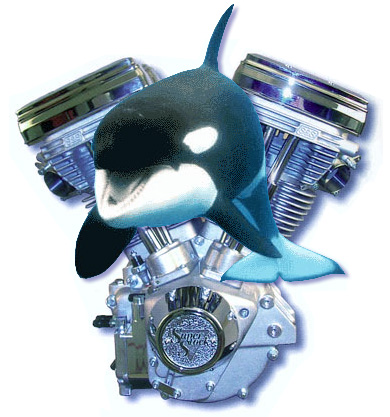
Fear Nothing, Kill When Hungry
Touring Bike?
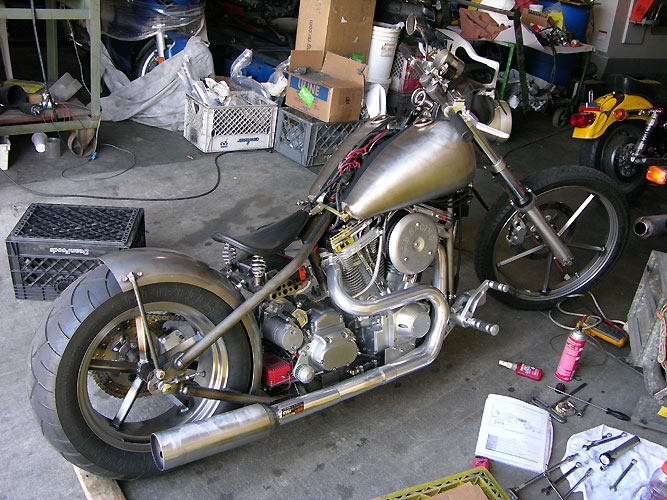
113 ORCA in a rigid frame. Owner assembled bike, loaded it in a truck, drove from East Coast to RB Racing in California. We spent two days trouble shooting the new bike that had never run, programmed it with Autocal.V6. The owner then dropped off the rental truck and drove the rigid across country back to the East Coast averaging 50 mpg. Not exactly what we would recommend, but in this case it worked out. To knock some noise off the RSR 2-1 Pro Stock we welded on a Pro Stock Spyder muffler.
We didn't even put the bike on our dyno...Just wrote the program and rode the bike a few times. Closed loop, high compression, 113" ORCA with S&S SA B1 heads.
Commonly referred to as "killer whales" they are actually quite sociable, intelligent air breathers that don't belong cooped up in some damn oversized fish tank. Like their sea going counterpart our 113/132/139 c.i. ORCA motors don't like being cooped up in your garage and are in fact quite sociable in their habits, devouring anything that suits their fancy all the while getting 40 to 55 mpg. Even held captive they will start, stop, and cruise without baring their teeth.
Shaker Nitro Rods by Carrillo
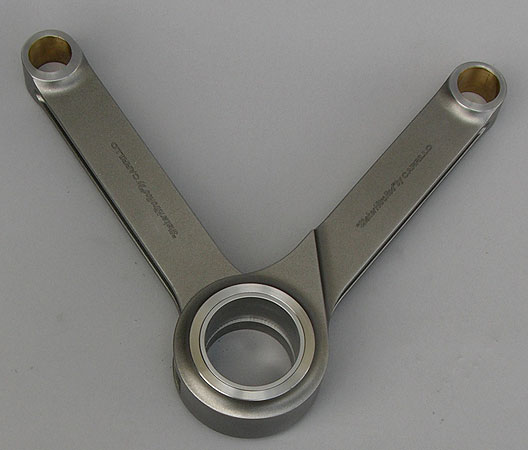
Reciprocating mass, the heart of the 139 Orca Engine. You've got the forged pistons, the crank and the rods. Every one of these points represents potential failure. Getting a set of rods that will withstand 400+ horsepower is a bit of a pain in the ass. Carl Pelletier built the first 139 Orca engine with McClure 8" rods. They were the only rods that were proven to take the pounding that Nitromethane hands out. The McClure rods were nearly impossible to get and we were not able to build backup motors for the Bullett project due to the inavailabilty of the McClure rods. We ordered them but none ever arrived. Carl had to buy a set from a third party to get the engine finished.
Terry Stewart of Shaker Products , a Carrillo distributor, faced the same dilemma and had Carrillo make up these "Shaker Nitro Rods" for us. Now this isn't exactly a big business for Terry or Carrillo but he put in the effort to get us our rods and to be able to supply rods on a regular basis for our 139 Orca Motors. Carrillo made a sronger rod than the McClure rods and their production techniques are more refined. Rods are just one part of the picture in a large scale project like the Bonneville Bullett, but an important one.
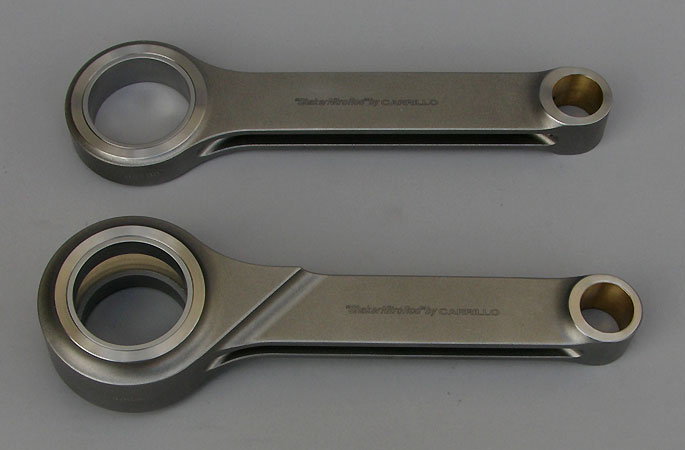
In the early 90's we ran 7.440" Carrillo rods in Mike Geokan's famous Blue Bike #226. They were ok but finally broke taking out the entire engine. These "Shaker Nitro Rods" have much thicker cross sections and are designed for nitro burning Pro Dragsters. Turbos are a bit easier on the rods, so these new "Shaker Nitro Rods" will not be a weak point in the engines. Contact Terry at (714) 398 7952 and be prepared to pay in advance for a set of custom rods. For us it's a no brainer...no 8" rods, no 139 Orca engines.
If you order a set of these have Carl Pelletier set up your entire lower end. He can keep your dragster alive for the season, not just a few passes. That's what we do.
Bad to the Bone
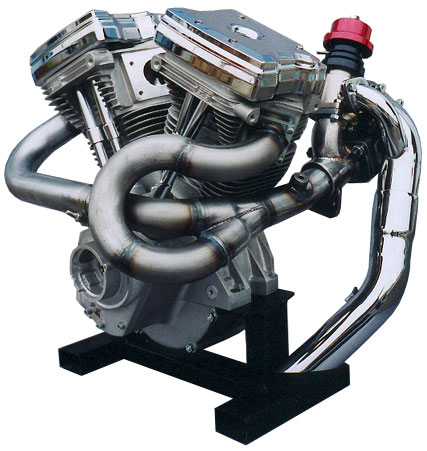
ORCA Engines...The Top of the Food Chain
ORCA's are big valve race engines that are set up as no-compromise air pumps. Full race heads, lightweight advanced pistons, race quality rods, gasketless sealing, high output charging systems and RSR Closed Loop Fuel injection. These are the highest tech engines you can buy that come with competition proven components. 200 mph Bonneville proven technology. National Drag Racing AHDRA Championship proven technology...all backed up by 17 years of Closed Loop RSR Fuel Injection experience, turbo and non turbo.
These are basically oversquare or nearly square engines that are not limited in their ability to breathe. They will not shut down due inferior small valve oem or aftermarket junk billet cylinder heads. Raised inlet and exhaust ports will outflow any standard two bolt port configuration.
Contrast these engines to "Billet" 120 inch engines that struggle to make 110 horsepower or dealer installed 120" engines that might make 120 horsepower. Both these are carbureted engines, not closed loop 56mm ( 2 3/16") RSR Fuel Injected engines. Contrast these carbureted engines getting 27 to 32 miles per gallon with a RSR Closed Loop efi system that will get 40 mpg in town and 50mpg on the highway. Instantaneous throttle response with full electronic control of idle speeds, choke functions and many other parameters versus crude carburetors. There is no comparison.
350 Hp TURBO ORCAS redefine "Bad". In fact they are so bad their DNA has to be kept locked up in a secure facility. Seven second quarter miles and a trail of broken hearts is their promise. Perfectly happy on the street, turn up the power based on the current threat condition. Take no prisoners. Pictured above is a 113" Turbo ORCA that will fit in most stock and aftermarket frames.
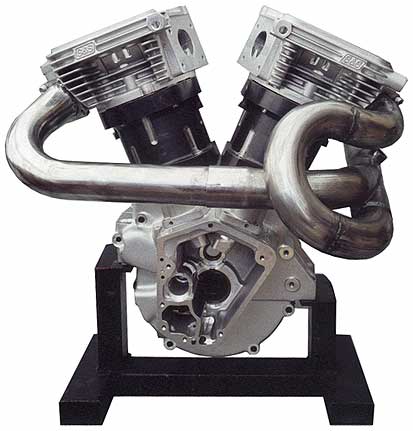

Pictured above is a 132" Super TURBO ORCA full race motor. Available in finless billet race cylinders with iron liners for drag racing. This motor was headed for Bonneville butwas diverted to a drag racing project. The Bonneville version features special waterjackets to prevent piston failure on an endless number of six mile long full boost passes on the long course at Bonneville. Street versions of the 132/139"Super ORCA with come with cast finned aluminum barrels. These motors are about one inch taller than stock so they are to be installed in racing or aftermarket frames. 132/139" TURBO ORCAS use full race double ceramic ball bearing turbochargers rated in excess of 500hp.
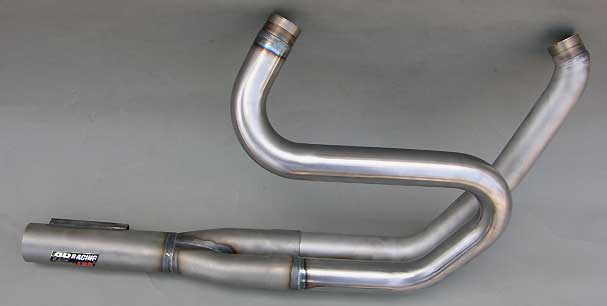
In addition we make the complete package to include the most advanced exhaust systems on the market, our Challenge series Pro Stock LSR 2-1 systems. These exhausts have already won AHDRA Championships. Other LSR 2-1 designs are available with an internal baffle and a variety of choices as to style and finish.
RSR Closed Loop EFI
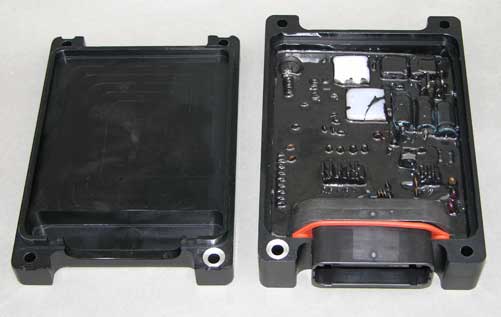
These are the competition proven, record holding, Bonneville and Drag Racing RSR EFI systems that have 17 years of experience behind them. The only closed loop system backed by RB Racing's Autocal.V6 Professional Software that allows you to edit or write a complete ecu calibration in minutes yourself. No authorized tuning facility required.
ORCA EVO Versions..Single Cam 113/132"/139"
Dating back 20 years the EVO design saved Harley's corporate ass. It took a few years for weak points to surface and almost 15 years for the aftermarket to gear up with specialized racing equipment. We've been closed loop fuel injecting them for 17 years and turbocharging them for 21 years. In the last 5 years the racing parts have pretty much settled down. Six years ago the TC88 motors came out. A 10 year old 96" S&S motor will outrun a TC95"....so much for progress. These dinosaurs still have the same bore/stroke limitations.
EVO ORCA Heights/Dimensions
Deck Heights 113 TC ORCA: Designed for stock frames except for raised ports which are higher than stock. The 132/139 ORCA is .590" taller than a stock EVO engine from crankshaft centerline to top of cylinder.
| Stock 80" EVO | 132" EVO ORCA | 139" EVO ORCA | 113" ORCA | |
| Stroke / 2 | 2.125 | 2.3125 | 2.3125 | 2.250 |
| Rod Length | 7.4375 | 8.0000 | 8.0000 | 7.440 |
| Pin Diam / 2 | .3955 | .4635 | .4635 | .4460 |
| Piston Top to top of pin hole | .984 | .736 | .736 | .7010 |
| Base Gasket | .0200 | None | None | None |
| Deck | 0.0000 (gasket .040") | .0400 | .0400 | .0400 |
| TOTAL Height Crank to Cylinder Deck | 10.9620 | 11.552 | 11.552 | 10.8700 |
| Difference in Height: crank centerline to cylinder top | +.590 | +.590 | -.0920 | |
| Crank Centerline to Crankcase deck | 5.375 | 6.375 | 6.375 | 5.875 |
| Cylinder Length | 5.587 | 5.177 | 5.177 | 4.995 |
Chassis Fitment
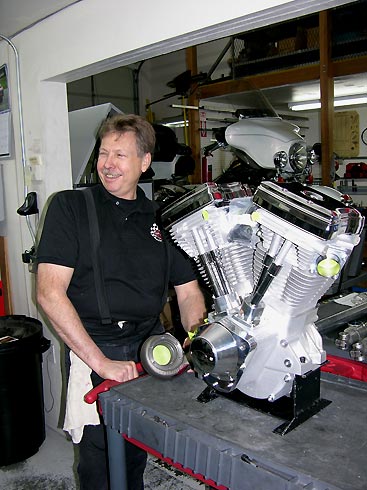
With their raised inlet ports ORCAS are not friendly with some models such as oem FXR's. Exhaust ports are also raised. RB Racing has special exhaust systems for the 4 bolt exhaust ports. On 132/139" ORCAS you best plan on a 1" taller engine in so far as frames go when you get to the rocker box covers. The rocker box height is about the same as stock for a 113" ORCA but the inlet and exhaust ports are higher (conflict with FXR).
Carl Pelletier with a 113" EFI ORCA engine destined for a custom chassis. A special LSR 2-1 Pro Stock Challenge system goes with the engine. Not turbo.
A second 113" ORCA engine is being set-up for a turbo at Competition Motorcycles (holding turbo housing). Carl is doing the specialzed preparation and cylinder head porting for the 350hp turbo set-up that is going into a Chopper Guys (non-oem) FXR chassis that has clearance for the 113 ORCA motor.
EVO STYLE ORCAS
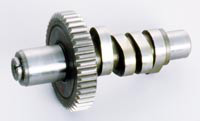
The simplicity of a single cam motor and the 20 plus years of development are hard to ignore, not to mention frames that are designed to accept these engines. You can put a TC case in an EVO frame (with an adaptor plate) but not vice-versa. All 45 degree V-Twins are speed limited by stroke, piston speed and bore size.
Given these limitations and the simplicity of the EVO design, it is often a better choice than the TC derived designs. Only one cam, no gear drives and proven over 20 years of racing make it a logical choice. Three displacements and designs are offered: 113 Cubic Inches four inch bore and 132 and 139 Cubic Inch models with 4.250 and 4.375"bores. All three models in turbo and normally aspirated formats.
113 EVO ORCAS are engines are 4.000" bore and 4.500" stroke using S&S Supreme Rods 7.440" c-c (.892" Piston Pins). 1.250" Crank Pin. SA/B1 big valve, raised port, four bolt heads. 11.0:1 (Normally Aspirated) or 9.0:1 (Turbo). Valve sizes 2.100" Inlet and 1.750" Exhaust. Single plug with electric compression releases on normally aspirated high compression motors. Dual spark plugs on lower compression turbo motors.
132 EVO ORCAS are engines are 4.250" bore and 4.625" stroke, and McClure Rods 8.000" c-c (.927 Piston Pins). 1.500" Race Crank Pin. SA/B2 big valve, raised port, four bolt heads. 11.0:1 (Normally Aspirated) or 9.0:1 (Turbo). Valve sizes 2.220" Inlet and 1.800" Exhaust. Single plug with electric compression releases on normally aspirated high compression motors. Dual spark plugs on lower compression turbo motors.
139" ORCA: Top of Food Chain
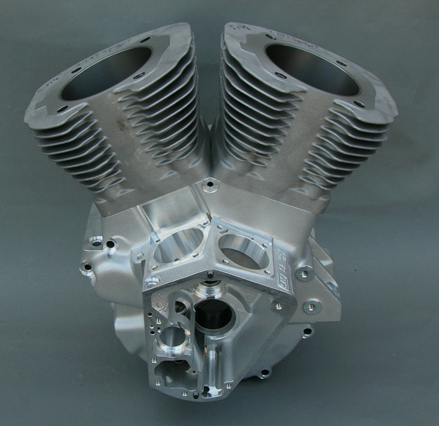
139 EVO ORCAS are engines with 4.375" bores and 4.625" stroke using 8.000" McClure Rods c-c (.927 Piston Pins). 1.500" Race Crank Pin. SA/B2 big valve, raised port heads. 11.0:1 (Normally Aspirated) or 9.0:1 (Turbo). Valve sizes 2.220" Inlet and 1.800" Exhaust. Single plug with electric compression releases on normally aspirated high compression motors. Dual spark plugs on lower compression turbo motors. External oil lines and internal piston oilers. Special 1/2" cylinder studs are used.
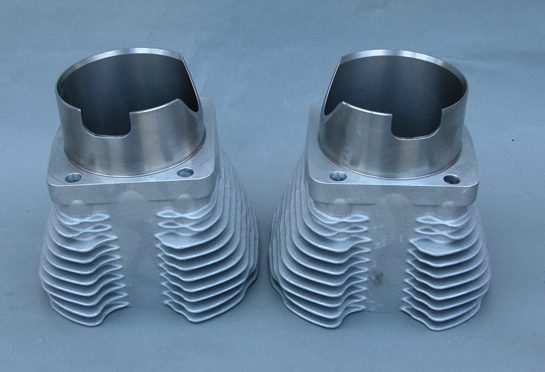
4 3/8" bore with notches for piston oilers. S&S custom made these air cooled cylinders for the 139" ORCA motors. They are set up for the 1/2" A1 Technologies studs. No head or base gaskets are used. Special gas energized silver plated Inconel seal rings and O-Rings are used.
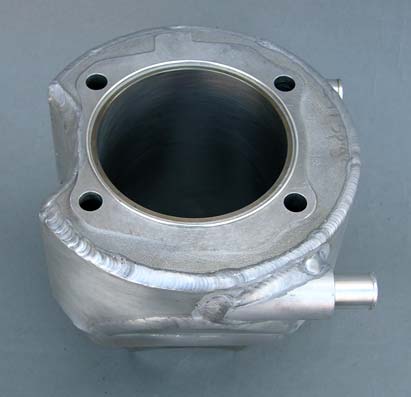
Inconel seal ring on watercooled 139" ORCA cylinder.
139" 400hp Turbo Pistons
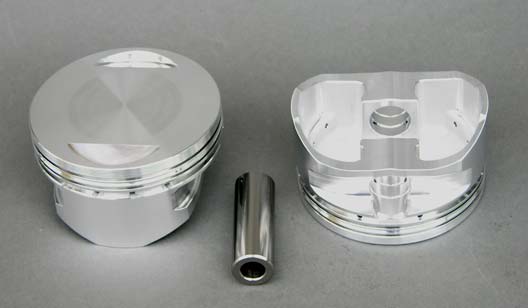
4 3/8" pistons relived for the 2.220 and 1.800 valves of the S&S B2 heads. These are under 500 grams and feature a lot of tricks we have learned over the years, not all of which we will show you. Heavy wall .927" piston pin, variously held in place by buttons or wire clips depending on our usage.
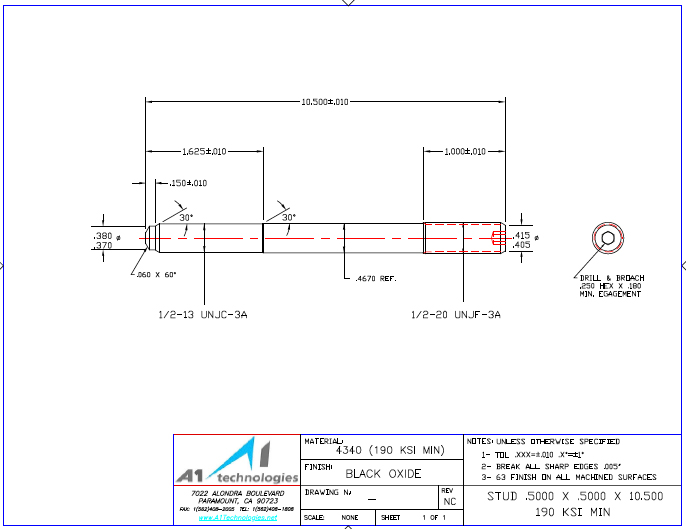
A1 Technologies makes our 1/2" ORCA studs. These are precision ground 4340 steel, oxide coated with rolled threads and special nuts and ground washers. S&S cut a special S&S Special application case for the 139" engine to a custom stud pattern.
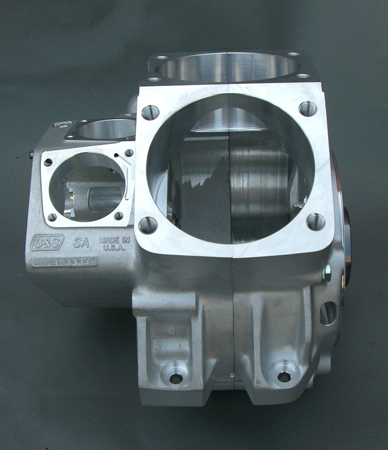
The 139" ORCA pushes the SA cases to the limit but we still have room for a base gasket O-Ring seal. Cases are tapped 1.625" deep for 1/2" x 13 studs. We have custom pistons made up for these.
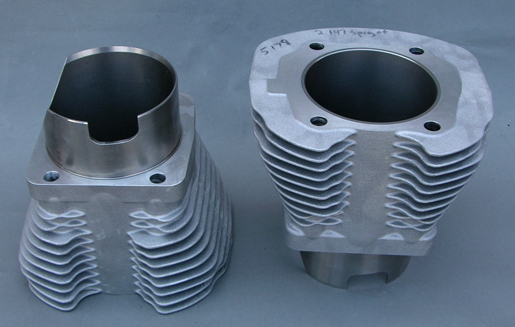
These are the air cooled cylinders for the 139" ORCA. The Bonneville Bullet of Mike Geokan uses watercooled cylinders, fed by a special pump and cooled by a radiator/fan combination. On the long course at Bonneville there will be so much heat generated that air cooling will not keep things stable when you are pumping 600 cfm of pressurized air in with the turbocharger.
Turbo
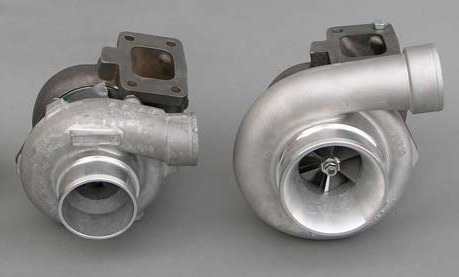
Turbo Options: RSR Fuel Injected Intercooled Turbos: 350hp. 600hp. Center mounted turbos for raked frames (40-45 degree) and left mounted turbos for standard frames. Systems are configured as 2 Bar or 3 Bar with either two or four injectors depending on ouput and user intentions. Turbos get machined, buffed smooth and coated and polished to show perfection.
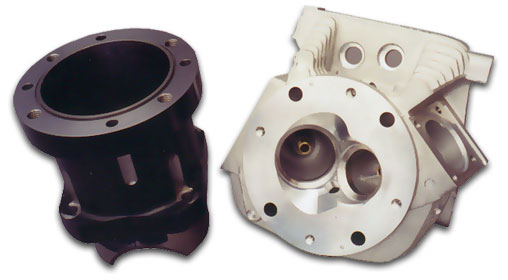
Finless Drag Racing cylinders for 132/139 ORCAS. Base studs like Shovels. Fire ring seal. SA head.
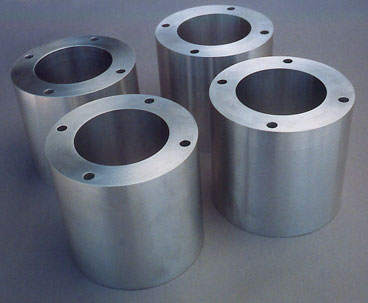
Water-cooled Bonneville 132/139 ORCA Cylinders. Wet liners ductile iron in a billet cylinder with press and O-Ring seals. Gas filled Inconel ring combustion chamber seal. Expensive stuff. Radiator, pump, hoses, all to keep the pistons alive for a six mile long dyno pull. Not new to us as we did it back in 1992. Bob George watercooled the Jammer Streamliner and the Easy Rider Streamliner along time ago. Dave Campos set the record.
The main difference between the two engines, beyond displacement issues, is the 132/139 EVO ORCAS are full eight bolt heads with base studs whereas the 113 EVO ORCAS are standard four bolt stud designs. Full drag race finless as well as cast fined designs are available.
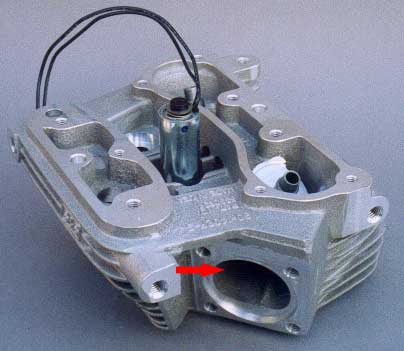
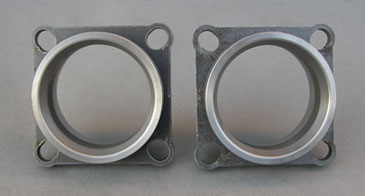
Both the 113 and 132/139 ORCAS feature four bolt S&S Special Application four bolt exhaust "SA" and B2 heads. Four Bolt LSR Exhaust Flanges shown on right.
ORCA Twin CamVersions..126"/139"
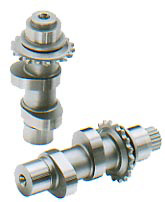
TC Style ORCAS: If you have a TC88 chassis then these are the motors for you as the engine cradles are different between the TC88 and EVO designs. The TC88 based designs are more complex and require gear driven cams. The pushrod geometry is improved but we still have a 45 degree V-Twin with limitations based on bore, stroke and piston speeds. Two displacements and designs are offered: 126 Cubic Inches and 139 Cubic Inches in turbo and normally aspirated formats.
When Harley decided to change engines they added the complication of two cams and a cam chain and, in the case of the "B" motors, they put in a counterbalancer to smooth out the rigid mount Softail engines. S&S quickly came up with gear-driven cams to get rid of the pesky chains. We use gear drive cams in the 126 and 139 ORCAS.
Heights/Dimensions
Deck Heights 126 TC ORCA: Designed for stock frames the 120 ORCA is .39825" taller than a stock TC88 engine from crankshaft centerline to top of cylinder. The 139 ORCA is .6170" taller than a stock TC88 engine.
| Stock TC 88 | 126 TC ORCA | 139 TC ORCA | |
| Stroke / 2 | 2.000 | 2.09375 | 2.3125 |
| Rod Length | 7.668 | 8.000 | 8.0000 |
| Pin Diam/2 | .4635 | .4635 | .4635 |
| Piston Top to top of pin hole | .8035 | .7360 | .7360 |
| Base Gasket | None | None | None |
| Deck | 0.0000 (gasket .040) | .0400 (no Gasket) | .0400 (no gasket) |
| TOTAL Height Crank to Cylinder Deck | 10.9350 | 11.33325 | 11.552 |
| Difference in Height: crank centerline to cylinder top | +0.39825 | +0.6170 | |
| Crank Centerline to Crankcase deck | 6.000 | 7.000 | 7.0000 |
| Cylinder Length | 4.9350" | 4.33325" | 4.552" |
Chassis Fitment
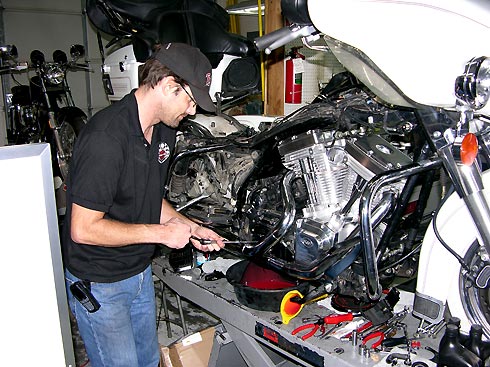
With their raised inlet ports ORCAS are not friendly with some models such as oem FXR's. Exhaust ports are also raised. RB Racing has special exhaust systems for the 4 bolt exhaust ports. On 139" ORCAS you best plan on a 1" taller engine in so far as frames go when you get to the rocker box covers. 126" ORCA fit stock chassis but inlet and exhaust ports are raised. Special four bolt SA B2 exhausts are required.
Here Competition Motorcycles in Boise Idaho is putting a 126 TC ORCA motor in a bagger.
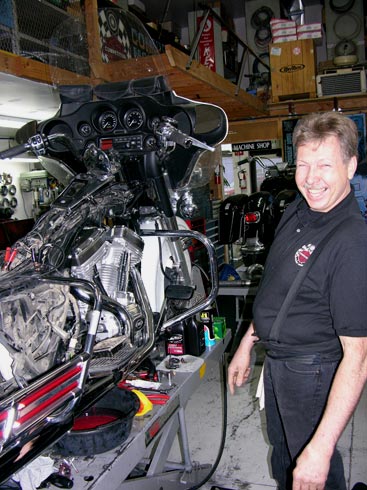
Carl Pelletier, somewhat amused at the thought of the LSR 2-1 Black Hole exhaust on the 126 ORCA motor. 150+ quiet horsepower. Quite a long way from the original low horsepower TC88 engine.
ORCA TC Cases
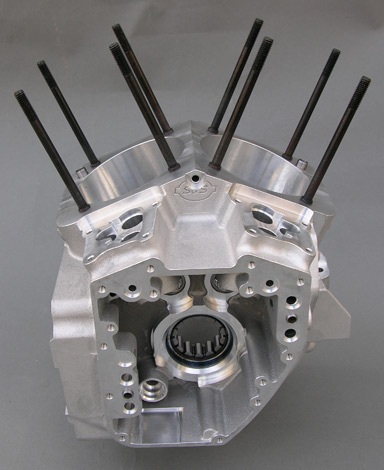
Hey! we're seven years into the TC era and some chassis are set up for the TC motors like your underpowered bagger FLH/T/Road King/Glide as well as the DYNAs. If you want to transplant 150 hp into these this is the way to go. Two cams, one cam what's the difference....they are still 45 degree 100 year old dinosaurs. 150 hp will get rid of the pesky GL1500's however.
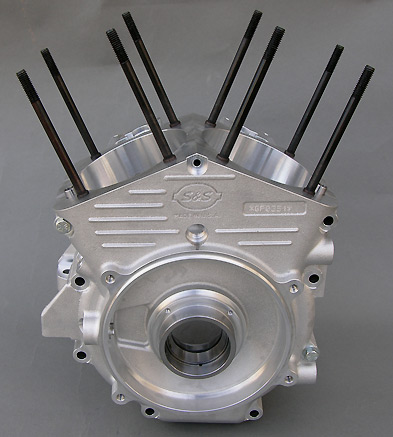
This is where you are going to put a 40 to 50 AMP three phase charging system because we're going to make you buy it. 25 amps at idle and 40-50 amps after that. Your RSR Closed Loop EFi System needs a stable electrical voltage.
ORCA TC Cylinders and Pistons
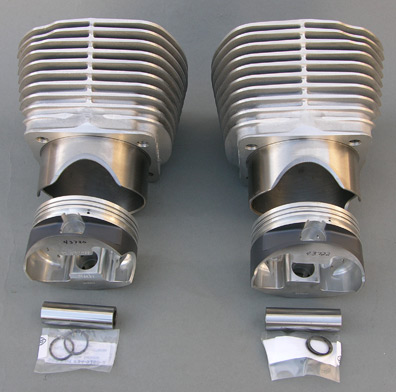
4 3/8" Bore with .927" pins. Lightweight pistons with optional moly coating on the skirts. Cast in liners to assure maximum heat dissipation for a street engine. No billet crap. Your basic 150hp street engine package to make your FLT/H or DYNA fly. Additional slots in liners are for piston oilers.
TC STYLE ORCAS
126 TC ORCA: 4.375" bore and 4.1875" stroke, and S&S Forged Rods (.927" Piston Pins). 1.500" Race Crank Pin. SA big valve, raised port, four bolt heads. 11.0:1 (Normally Aspirated) or 9.0:1 (Turbo). Valve sizes 2.220" Inlet and 1.800" Exhaust. Single plug with electric compression releases on normally aspirated high compression motors. Dual spark plugs on lower compression turbo motors.
139 TC ORCA: 4.375" Bore and 4.625" stroke, and McClure Rods 8.000" c-c (.927" Piston Pins). 1.500" Race Crank Pin. SA big valve, raised port, eight bolt heads with four base studs. 11.0:1 (Normally Aspirated) or 9.0:1 (Turbo). Valve sizes 2.220" Inlet and 1.800" Exhaust. Single plug with electric compression releases on normally aspirated high compression motors. Dual spark plugs on lower compression turbo motors.
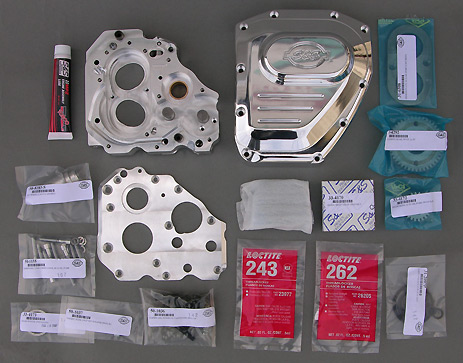
Different pumps for different folks. S&S came up with this rather expensive solution to how to oil a TC motor. Certain of our "C" style exhausts are not compatible with the chunky cover and we have special "C" style pipes that do fit...say if you want this pump and have an FLT/H Sled.

Turbo Options: RSR Fuel Injected Intercooled Turbos: 350hp. 600hp. Center mounted turbos for raked frames (40-45 degree) and left mounted turbos for standard frames. Systems are configured as 2 Bar or 3 Bar with either two or four injectors depending on ouput and user intentions.

Finless Drag Racing cylinders for 132/139 ORCAS. Base studs like Shovels. Fire ring seal. SA Head.
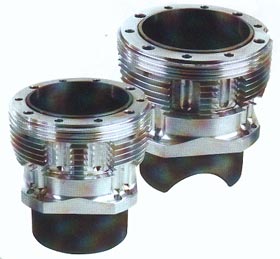
Billet finned cylinders with eight bolt heads for 132/139 ORCAS. Base studs like Shovels. Fire ring seal.

Water-cooled Bonneville 132/139 ORCA Cylinders. Wet liners ductile iron in a billet cylinder with press and O-Ring seals. Fire ring to combustion chamber seal. Expensive stuff.
The main difference between the two engines, beyond displacement issues, is the 135 TC ORCAS are full eight bolt heads with base studs whereas the 126 TC ORCAS are standard four bolt stud designs. Full drag race finless as well as billet fined designs are available.
135/165/350/500 Hp "SA" ORCAS - No Cheap or Dumb
Billet Shit 
S&S Special Application Cases. S&S Special Application Heads. Custom Forged Pistons. Forged rods. Titanium retainers. High strength competition proven components, the same stuff we use on our Bonneville bikes. If you think carving your cylinder head and barrels out of chunks of aluminum makes any economic or rational sense then the line forms to the right where you can fork over an extra $4,000.00 for some inferior shit. Get out your aluminum polish and park your scooter because an ORCA will eat your lunch for less money. Dual Mikuni carburetors hung out in space on a turkey neck manifold versus RSR PC programmable closed loop Fuel Injection is like sending a Sopwith Camel up to do battle with F16 fighter jet. Port Fuel Injection and complete computer control beats the shit out of fuel meandering down some aluminum drainage ditch that runs into your leg. Some people will dream up anything to sell chunks of aluminum.
Turbo "SA" ORCA Heads
If you think your billet wonders flow more than these raised port special castings then you still think Henry Ford should have stopped with the Model T. It simply does not make sense to take 40 lbs of aluminum and try to carve all the nuances that thousands of manhours of development can put into a dedicated special purpose casting. Ferrari V10 Formula 1, Illmore (Mercedes) V8 and V10, Porsche 6 Cyl, Factory Chevrolet Corvette V8 Racers, Dodge Viper V10 (world champion), Jaguar(Ford) V10 Formula 1, Honda V10 Formula 1 all use dedicated castings for their cylinder heads. You figure out who's stupid. Turbo ORCAS feature special metallic seal rings that prevent the four bolt castings from spitting out the head gasket. It can't spit out the head gasket because there isn't one. The chambers are deburred and hand smoothed to prevent any detonation flash points from occuring. Since Turbo motors are around 8.5:1 starting is not a problem and no compression releases are necessary. You can order the electronic compression releases pictured below for even easier starting if you so desire. Check out our RSR Inlet Valve Mach Index Calculator to see how ORCAS are set up. To see fully port matched heads you can go to our SA Head Tech page.
132/139" Super ORCA 8 Bolt Heads

When you go for big, big, numbers, double down on the head bolts and shit-can the long elastic studs. 135" Super ORCAS return to hardcore racing technology to keep their heads on...Eight ARP fasteners hold the heads to the barrel...Four up and four down.

Whether in finless drag racing barrels or in finned aluminum street versions, four short, stiff studs hold the barrels to the case. No gaskets are used either above or below, just sophisticated rubber and metal o-rings. When things get taller and taller with cases at +1" and 8" rods, there's a lot of expansion going on. It's best to use proven racing technology just to be sure.
High Compression "SA" ORCA Heads
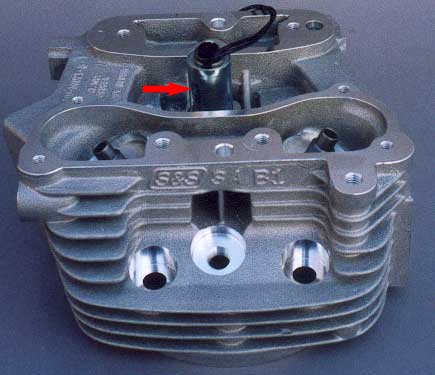
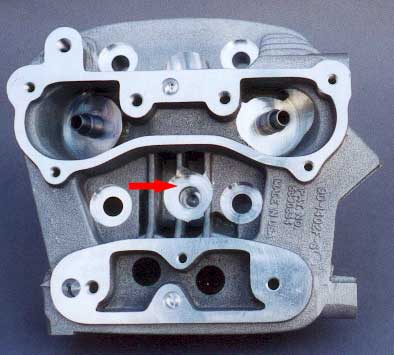
Same big valves as our Turbo ORCAS but these Special Application Heads feature S&S electronic compression releases that integrate into your starter motor circuit for completely automatic operation. When you "hit" the starter they pop open and the motor spins freely as the solenoid opens a circuit from the combustion chamber directly to the exhaust port. When the motors fires and you release the starter button the circuit closes. As you can see in the two photos above, the solenoids are installed in the center of the rocker covers neatly out of sight. Like our Turbo ORCAS these high compression heads feature special metallic seal rings that completely eliminate the troublesome head gasket.
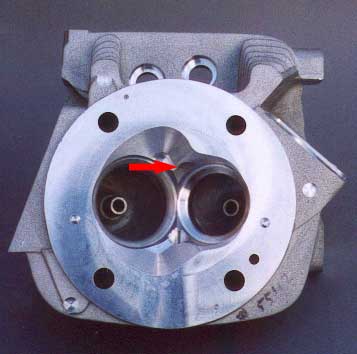

Unlike crude "chainsaw" aftermarket compression releases that intrude into your combustion chamber these S&S designed releases only require a tiny orifice into the combustion chamber (see photo to left above). This prevents carbon fouling of the poppet and insures that the intense heat in the combustion chamber will not be in direct contact with the mechanism itself. This also eliminates any hot spots and weaknesses that the installation of the "chainsaw" style releases bring with them. As an added touch of sophistication these new releases vent directly into the exhaust port which is cross-drilled to intersect with the compression releases poppet valve (see photo above right). With compression ratios from 11.54 to 14.0:1 these are mandatory for easy trouble free starting. We won't bore you with the sorrid technical details of starter motors and big inch motors when paired with RB Racing's RSR Electronic Fuel Injection...suffice to say these new S&S electronic compression releases will become your best friend.
The heads pictured above are for the standard 4 bolt pattern. 132/139" Turbo ORCAS use an eight 3/8" ARP bolts to secure the head to the cylinder and large diameter studs to secure the cylinder to the case.
High Compression S&S B2 Heads
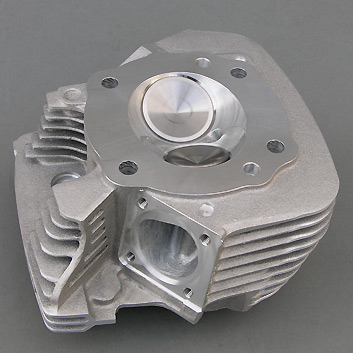
The exhaust ports are essentailly the same as the SA heads except, of course, the valve size ups from 1.750" to 1.800". The exhaust pocket in the B2 heads is a bit smaller than the SA casting. We have special turbo venturis machined up for both. Four bolt flanges for both although the bolt centers are different. Generally one spark plug and electric compression releases for the high compression motors. Twin plugs for turbo motors.
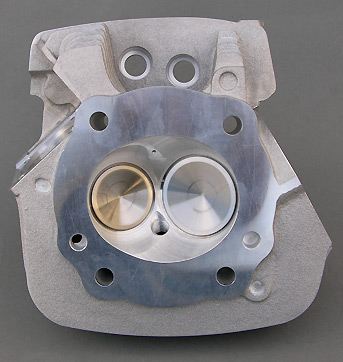
Pin hole is for the electric compression release. Chamber has basically been designed to unshrould the large valves and still yield a high compression with a flat top piston. 2.220" Inlet. 1.800" Exhaust.
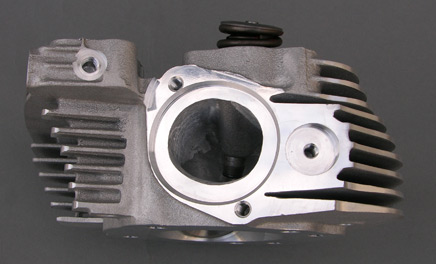
Holy oval inlets Batman! This sure doesn't look like billet crap! Take a close look at the fin structure and ask how the billet guys are going to machine that sort of fin. That's why the billet heads are good for polishing but not good for getting rid of heat.
When we are talking about airflow it's a subject that's unique because we are dealing with something that is surrounded by flowery descriptions and hyperbole but, which is, in fact, quite invisible and hard to verify. You've heard all the pros and cons of mirror finishes, rough finishes, directional vanes, 5 angle valve jobs, blended radiuses, D-shaped radiuses, raised decks, slim valve stems, tapered and cut off valve guides, hand ported, cnc ported, swirl technology, wet flow and dry flow testing, and about a dozen other wazoo anti reversion pulse modulated laser controlled death ray technologies.
ORCAS take this airflow business seriously because these are nothing but two lunged air compressors with two big inlet valves that have about as much chance of being efficient as a modern Formula 1 engine as does that snowball cruising through hell. ORCAS hate polished ports which grab the air like peanut butter sticks to the roof of your mouth. ORCAS employ roughened ports that emulate their sea dwelling cousins to keep the port speeds high. ORCAS don't use flattened or excessively radiused valves because they either kill the peak flow or compromise the low speed flow. ORCAS employ sophisticated short turn radius trench cut techniques developed in Porsches and NASCAR to increase the flow on the short or inner surface of the port radius. ORCA SA motors staighten out the ports like any modern race engine tries to do...granted the valves aren't set at 10 degrees to the bore, but what the hell, we gotta get them in the frames. Valve seats and angles are decidedly non tricky because they have to survive in the real world where razor thin seats disappear faster than you know who at closing time.
Bigger ports aren't better ports...but small valves and smaller ports will limit horsepower in these big bore motors. Velocity is king. Piston speeds are a variable in the four stroke cycle and you must flow the ports to reflect this. Testing the ports at 10 to 12" of water is a waste of time as was proven by Smokey Yunick over 40 years ago. A little bit of sandpaper can do something a canned cnc program can't...and all the ball end mills in the world can't machine a real ORCA's skin. Nature rules. Art can't always be shrink wrapped.
Premium S&S
Special Application Cases 
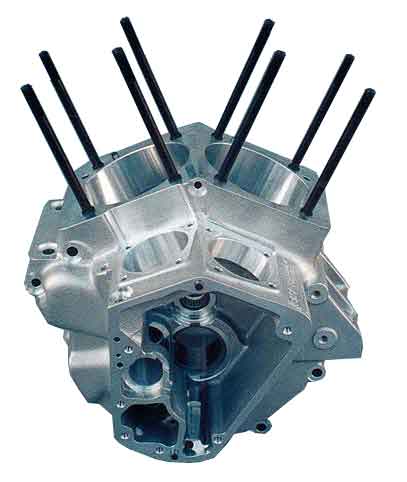
No fooling around with cases that can't take the heat nor the large bore that a 113/126/132/139 c.i. motor requires. Heavy duty Special Application crankcases are proven items that serve both street and competition in thousands of installations. Unlike some builders who take S&S and other manufacturers crankcases and put their "billet" cylinders on them, we insist on using genuine S&S cylinders because they are superior. S&S casts a special splined sleeve into the 113" cylinder just like the Harley factory does. In addition, all S&S cylinders are stress relieved to maintain bore concentricity and good ring seal and oil control. This provides a stable, superior heat transfer and more dimensional stability than a pressed in sleeve that is subject to distortion and heat transfer problems. If you think polished billet cylinders with pressed in sleeve are better you would only be right if you were parking your bike and polishing those fins that keep corroding all the time. Remember, crows like shiny objects so don't park that billet wonder under a tree.
ORCA Motors are developed on sophisticated ORCA Transient Engine Dynamometers that measure the rate of transient acceleration which is the key to successful engine development. Peak Power may be impressive but it's torque that gets the job done. How fast an engine will accelerate from one rpm to the next as in when you shift and grab the next gear is the real secret to "killer engines". RB Racing has special ORCA Transient Engine Dynos to develop 113/132 ORCA motors.
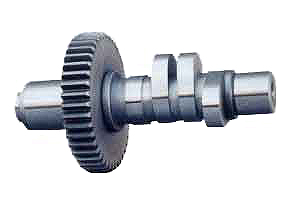
We use pistons and cams of our own design. If you have a particular camshaft that you desire, you can supply it or we will get it for you. Don't even think about cams if you are looking for lifts under .600". All ORCA pistons are set up for .630" lift cams and inlet valves with a diameter of 2.100" that our S&S SA motors use. As for pistons we have designed some lightweight forged pistons (see text below for a detailed description of these pistons) that compliment our fuel injection's ability to more accurately control the fuel delivery without detonating. We have pistons and cams for both our ORCA and Turbo ORCA motors, all Bonneville proven stuff that has come out of nearly a decade of testing. To see what the effect of camshaft selection is on the dynamics of engine operation check out our Advanced Dynamic Compression Calculator.
Advanced Dynamic Compression Calculator
When you are planning an engine you need to understand the relationships that exist between cam timing, static compression, rod length, bore, stroke, altitude and in the case of RB Racing Turbos, boost pressure. We have created a calculator that lets you play around with design parameters and have a good idea of how the engine combination will wok out for your intended usage. By focusing on the dymanics we avoid the trap of looking at fixed or static values which can often be misleading. Plug and play before you buy and try!

You just can't outrun a turbo, its that simple. Even at 8 psi one of our Turbo (9.9:1 c.r.) ORCAS will put out 175hp and monstrous torque. Up the boost to 12 psi on our 350 hp unit and you'll be way, way past 200hp. The turbos will go past 30 psi and are available in 350hp and 500hp varieties. Do not confuse boost with airflow...we do not use stupid ass variable vane low cfm rated turbos that were meant for low speed diesels or snowmobiles! We move a lot of air at low boost without excessive backpressure which is why our turbos produce so much horsepower at low "boost" levels. Confuse boost with cfm of airflow and you will lose everytime. In case you're wondering how fast is fast...try these numbers 179mph @ 7.9 seconds in the quarter mile and 144mph @ 4.8 seconds in the 1/8th mile! We also make them for specialized drag racing motors that will go to 500hp but that has nothing to do with your street bike.
___NoteS&S Cycle and Bonneville
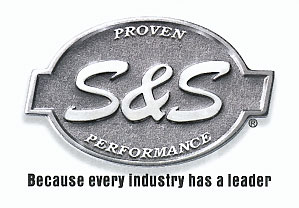
When you go to Bonneville S&S Cycle is usually there...and if they aren't, a lot of their equipment is there. There is an incredibly long list of people who have set records there with S&S equipment going back five decades to 1954 and George Smith Sr., the founder of S&S. Some of the people we race with, like Mike Geokan, have been around long enough to have known George Sr. Our involvement came much later, starting in the mid 80's.
We use S&S engines because they have proven their worth and S&S is a reliable partner, not a fly by night late comer. We get to do our own thing, set things up our way, experiment and they don't try to strangle our creativity. S&S's strength is in their customer support and their involvement with the sport. You need strategic partners if you plan on attaining your goals. None of us walk alone and plenty of people have paved the way.
Turbo Water Injection
We now are offering Turbo Water Injection with all ORCA Turbo motors. We have always run water injection on our Bonneville bikes and since people always want more power, water injection is the only safe method of running more boost. Our new RSR Water Injection Calculator shows you how it works.
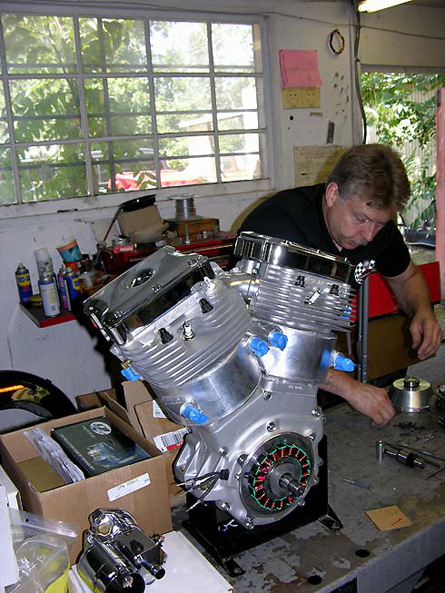
Both
"SA" and "SS" 113/126/132/139 c.i. ORCA Motors are available
in full
turbo build. Carl Pelletier of Competition Motorcyclesand RB
Racing have taken
our RSR Fuel Injected Turbos into the record books at
Bonneville and
Wayne Pollack and Ken Browne have taken them to nearly 180 mph
in the
quarter mile. These engines feature all that we have learned
in over 20
years of turbocharging the Harley V-Twin. The is no one else
who has
pushed the limits like we have, nor is there anyone who has
made the
investment we have to make this possible. Bonneville is a
seven mile
long dyno that leaves engines in smoking, twisted chunks of
jagged
metal. We have never lost an engine there. Oh, we stretched
valves, we
broke transmissions, and we made some dumb ass stupid mistakes
but we
never lost a motor. 275hp @ 6000 rpm on a 104" motor for run
after run.
New 139" ORCA motors are over 400 horsepower.
Turbo ORCAS use forged 9.9 compression Turbo Pistons, special high temperature Titanium and Inconel Valves, special head and base gasket seals, forged specially designed connecting rods, turbo camshafts, oversize bearings and shafts and hand fitted and clearanced parts to handle the elevated power outputs.
Weight is your enemy. Strength is your friend. ORCA pistons are both lightweight by design and forged for strength. Hp equals torque x RPM / 5225. As the RPM increases things get really interesting inside your motor. At 6400 RPM your piston is pulling 9000g's of acceleration...and at 7200 RPM this rises to 10125g's! A typical Harley Evo 80 inch piston and pin combination weighs an astounding 12,251 lbs at 6400 RPM! Your typical 113" four inch bore normally aspirated high compression piston and pin combination often weighs as much as 856 grams which, at 6400 RPM and 9000g's of force, will weigh a whopping 16949 pounds! And people wonder why their rods and lower ends go away!
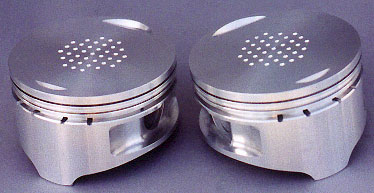
Shown above are our new 113" 9.9:1 turbo pistons...don't ask what the dots are. Heat is power, but you want to mimimize the surface area on the piston crown so that the heat gets put to use driving the crank and not just trying to melt your pistons. All ORCA pistons are set up for .640 up to 675" lift cams because if you don't get the valves open this much, the Special Application "SA" heads are going to waste. SA Heads are designed to prevent shrouding the 2.220" inlet and 1.800" exhaust valves and to direct the burn to the exhaust valve. Getting things to burn quickly in bore 4 inches or greater is an interesting subject. Don't try 9.9:1 on a non-ORCA motor because it will detonate if you look at it.
ORCA pistons are made in the latest forging dies which minimize the extra weight by eliminating unnecessary dome thicknesses and stupid ass features like ribs and other gizmos that cause uneven piston growth and actually promote failure. If you think about the acceleration and weights involved you can see why we are so fanatical about weight and strength. When you get up to these 4 inch or larger bore motors the stock wrist pins simply won't cut it anymore. All ORCA motors use genuine S&S tapered .892" or .927" piston pins in lieu of the stock .791 / .792" pins. Strength goes up with the square of the diameter so you figure out how much strength we gain by doing this. Some stroker kits have even gone to smaller pins to put fatter and heavier rings on their pistons. . ORCAS don't go around with "FOOL" stenciled on their piston skirts so we opted for the latest lightweight ring package on the market.
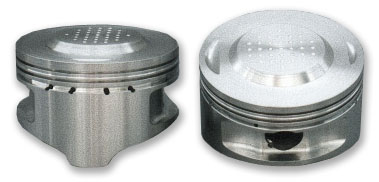
Above are a set of fully machined 113" ORCA "Active Pistons" used in an 11.54:1 (Static) compression motor. A description of these can be found on our ORCA Piston Tech Page.
We make the piston/ring/pin package stronger than stock and keep the weight equal to stock...If this doesn't make sense to you then you're probably not paying attention to all these 9000 "g" forces and 16,000 pound pistons we've been talking about. It's funny, but most people just put in the pistons and don't think about the consequences. This is reciprocating weight and if we can build a lighter, stonger part we have an obligation to do so. The lighter we can make these parts the faster the transient acceleration we can achieve and the less strain we will transfer to our main bearings and piston pins. Pictured above are our high compression normally aspirated ORCA pistons. There are no weak points in these pistons! The additional compression can lead to starting and starter motor problems, especially if the battery is a bit weak. For this reason we use S&S electronic automatic compression releases on all compression ORCA motors. The pistons pictured above have more dome that the S&S "SA" chamber allows...we machine them to the desired compression ratio. They end up lighter than stock pistons.
All ORCA pistons are machined from a heat-treated, low expansion, alloy and can be run with clearances as tight as .0025". For pure race applications these tolerances can be opened up but we always recommend that you break in these piston / ring packages in with regular 20/50 weight mineral based oil for at least 1000 miles before you switch to a synthetic based lubricant like Mobil 1. If you rush the process you may not seat the rings. Compression ratios are available from 11.54 to 14.0:1. All high compression pistons receive special hand contouring to remove any sharp edges that lead to detonation and special secondary machining operations to promote fast burn in these four inch bores.
For those of you out there with some larger bore motors, say maybe 131"...we've seen dome thicknesses on these engines down to .125". Bye bye piston crown! Dome thickness on our ORCA Turbo pistons is .300" and less on the normally aspirated ones.
Usually motors are assembled by hourly wage earners who spin wrenches but don't race or have not actually seen any real competition. The reason for this is simple: employers find out sooner or later that eager enthusiasts make lousy employees because they love to talk, want to get deals for their friends, and tend to get disgrunteled when they find out that hard work is just that, hard work. 113/126/132/139" Orcas are assembled only by professionals who have proven they have the work ethic and a record of accomplishment that insures only the best work will be done based on both discipline and knowledge, not to mention a substantial investment in specialized tools and metrology (measuring equipment).
A minimum 20 years of professional experience in Harley engines, including multiple world records in competition. Twenty years of professional aircraft A&P experience plus entensive Harley engine building experience not mention more road miles than you would believe. Eighteen years of professional Harley-Davidson experience to include National Number One drag racing plates as well as experience in sophisticated IBM mainframe and medical imaging mechanical issues. 113/126/132/139" Orcas are assembled to specific SA, SS, or Turbo specs by the most experienced and capable professional who has the actual knowledge of the intended useage.
The big twin is not a complicated motor but on the other hand its lack of "modern features" such as unit construction, horizontally split cases, integrated cylinders and cases, and minimal sealing faces all are recipes for potential problems if the "builder" does not have enough knowledge of common mistakes and errors. Nobody and we mean nobody assembles and dynos an ORCA unless he is a thorough professional.
Before we get into the specifics of how sophisticated ORCA Motors are or what they cost, we should shed some light on what an inferior "billet motor" costs.
Base price billet 113" motor $8,905.00
In case you were wondering where your money goes when you buy a base price "billet motor" for $8,905.00, we offer the following evidence on the cost of these billet parts:
Billet Cylinders (pair) for 113c.i. motor (4.0" x 4.5") $1,487.96
Billet Cylinder Heads for a 4" Bore____________ _$2,750.00
___________________________________Total __$4,237.96
Thatís Four Thousand Two Hundred Thirty Seven Dollars and Ninety- Six Cents of your hard earned money for two inferior cylinders and two mediocre cylinder heads that are not by any stretch of the imagination race ready. Well at least, they are shiny and you can polish them.
The balance of your money, $4,667.04, gets you guess what?Ö S&S flywheels and rods and either S&S or Delkron cases. Hell, a genuine Harley Davidson 80" motor can be bought complete for about $3,000.00 so it looks like a lot of your $8,810.00 is going for advertising and cnc machine tool payments. Not that we want to scare you to death, but there are engine builders that will screw together a 113" S&S motor for you for about $5,500.00. There is some funny accounting going on here, sort of like when you go fox hunting and you hope the foxes canít keep track of how many hunters left and how many stayed.
As a final insult these billet engine builders will give you a single 42mm Mikuni which works out to about 1 5/8" for this 113" motor to breathe through. When is the last time you saw such a small carb on a big inch motor? Drag racers wonít saddle their motors with small carbsÖWhy should you? For a mere $1,775.00 these billet clowns will stick a dual Mikuni carb set up on a long gooseneck casting on your 113" billet wonder...Fuel separation in cold weather?... Better not bring up that issue. This brings your billet wonder to nearly $11,000.00 when you add in the usual extras. In case you didnít get the messageÖIf you want to overpay for some shiny billet parts go right ahead, but we bet your mother didnít raise you to be a fool.
We take a different approach to this power business and damn if we havenít spent over 20 years trying to make insane levels of power. Charles Fayette Taylor, the famous MIT professor who spent a lifetime studying the internal combustion engine is quoted as saying "Iíve never seen a new engine make too much power". We concur. To this end we decided that only full race components with the latest port designs would be used in our Fuel Injected ORCA motors.
Itís the Airflow, Stupid!
S&S Special Application cylinder heads with their inlet ports raised .500" with directional vanes that lead to a huge 2.220" valves and their revised exhaust ports with square four bolt flanges fit the bill perfectly. No billet piece of shit will stand toe to toe with these. In case you arenít engine savvy, but just want the best, we ought to clue you in that the power game is all about airflow and accurate fuel metering. For the less than technically impaired we offer the following SS SA Head Data:Typical intake port flow is 195 cfm @ 10" of water; Typical exhaust flow is 147 cfm @ 10" of water. Billet parts are a total compromise that cannot equal the flow rates of this dedicated special purpose casting. Inferior fin structure, inability to machine the exact details that can only be achieved through the casting process relegate billet parts to show bikes where parking and talking is the norm. S&S Special application heads also use large 1.800" exhaust valves which have been proven to be perfect for high revving 113/126/132/139" motors.
Splines, Cool Dudes and Slick Willies
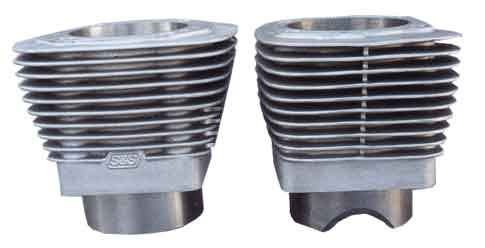
Those billet cylinders that the billet vendors ask you to fork over $1,487.96 for use pressed in sleeves that do not have the special splined features that OEM Harleys and S&S cylinders feature. The splines greatly increase the surface area of the liner and thus provide a heat transfer that a pressed in round sleeve cannot hope to match. In addition, all S&S cylinders are stress relieved in a heat treatment process which insures stable bore dimensions under all operating conditions. Pressed in sleeves cannot offer this sophistication. Aluminum and iron do not expand at the same rate. Put a round sleeve in a round hole on a 4" or 4.375" bore, heat the motors up and who knows what the hell is going to happen. Do the same thing with a cast in splined liner that has been heat treated and the bore stays round. As for the Slick Willies, well, theyíre the ones selling you the billet parts.
Bonneville Metal Seal Rings
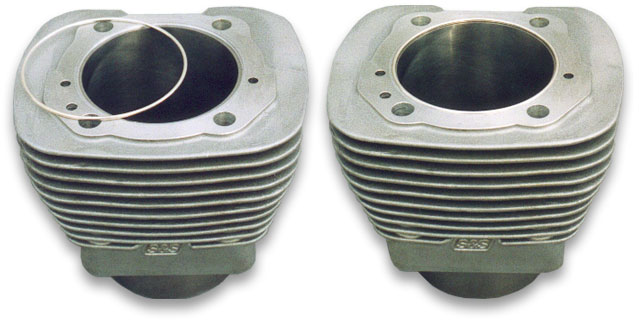
Run 22 pounds of boost for seven miles, pumping out 275 hp and that old head gasket will surrender to the blowtorch of combustion. The hot gases will find the weakspot and cut the head and cylinder quicker than an ironworker can cut a structural beam.
Our Bonneville experience is your gain because all 113/126/132/139" ORCAS do not use any normal composition or copper head and base gaskets that can fail. Upstairs we use ultra-expensive silver plated hollow metal o-rings that provide a self-energized, dynamic seal between the cylinder and the head. This is the only method short of electron beam welding the head to the cylinder to prevent leaks. Downstairs we use a high temperature O-Ring between the cylinder and the S&S Special Application Crankcases. Once again, this is something we have proven in actual competition at Bonneville and you get the benefit of our experience.
You'll never see silicone, hylomar, or gaskets getting pushed out to ruin your day! There are extra benefits from this madness in the area of heat transfer, but that's another subject. Splined liners, sophisticated castings, metal o-rings and gasketless assembly beat polished pieces of billet crap in every time. The great white dyno (Bonneville) is merciless. Tech on Sunday...break on Monday...go home Tuesday, is the general rule. We run the full week.
Our 132/139" eight bolt head ORCAS use a mechanical fire ring seal and O-Rings.
Itís The Fuel, Stupid!
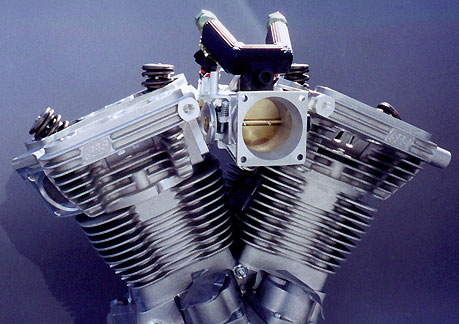
RSR Closed-Loop Fuel injection feeds your ORCA motor through a huge 56mm (2 3/16í) throttle body and electronic fuel injectors that are located in the inlet manifold for true port injection. The exact computer control of the fuel delivery will guarantee you 40 mpg city and 54 mpg road mileage and an instantaneous throttle response that will make you think you have moved up to Top Fuel. If you think either one or two Mikunis will beat a Closed Loop RSR Fuel Injection system then maybe you should be lining up to buy a Ford Pinto for your next performance vehicle.
The ORCAíS RSR Closed Loop Fuel Injection is PC programmable for the ultimate in tuneability. Absolutely no jets to fool with and no more unscrewing float bowls with gas going everywhere. Computer control of idle speeds, no choke levers, and a huge 2 / 3/16" (56mm) throttle body guarantees perfect driveability and unlimited performance. Sensors measure, air temp, engine temp, barometric pressure, throttle position, exhaust gas content, and manifold pressure, making corrections hundreds of times per second, something a carburetor cannot do.
This is the same RSR Fuel Injection that has powered multiple 200 mph Bonneville and El Mirage speed records and powered turbocharged big twins to seven second quarter mile times at 176mph! Try that with your stinking 42mm Mikuni! Precise control of your fuel delivery is only possible with electronic fuel injection and RB Racing has over 16 years of competition experience and over 1,000,000 miles of road miles to insure it is the finest fuel delivery system possible for the big twin.
Cosworth Pectel SQ6M
controllers with Fly-By-Wire throttle control and over
8800 programmable features push the limit of what you can do.
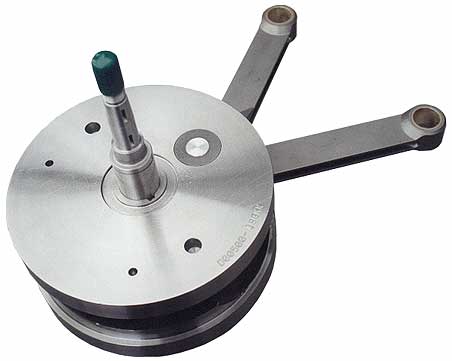
Normally aspirated and turbo 113" ORCA Motors use S&S Supreme 7.440" connecting rods with .892" pins for their stength....While they are heavier than similar length H-section rods, they are stronger and support the wrist pin better under 200 plus horsepower loads.
Normally aspirated and turbo 132/139" Super ORCA Motors use 8" McClure Nitro-proven H-section connecting rods with .927" Chevy pins. Billet motors will set you up with standard S&S "I-Beam" or lighter Carrillo rods and not even the super duty S&S Supreme rods. We have broken lightweight H-beam rods in both Nitro and Turbo motors. Pictured above is a fully machined and balanced 132/139" Super ORCA crank assembly with the 8" McClure rods.
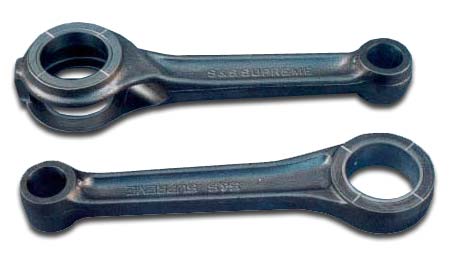
While our 113" ORCA motors use "I-Beam" S&S Supreme rods, our 139" ORCA Motors, where horsepower runs from 160 to 350, use special 8" Nitro-proven McClure rods with Chevy spec .927" pins. The McClure rods also use larger crankpins and special rollers as the potential horsepower exceeds the normal roller bearings limit. Pictured above are the rods we use in our 113" ORCA motors.
Charging Systems
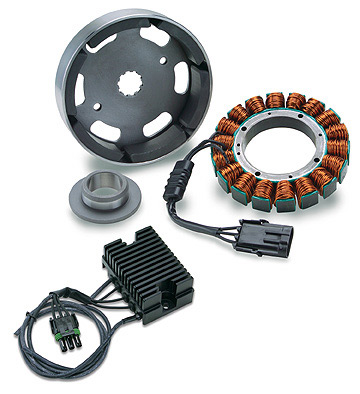
No electricity, no RSR EFi. All ORCA motors come with a mandatory high output charging system to support your RSR EFI Systems as a well as a high amperage ignition system. Old 23 Amp systems are useless. 32 Amp systems are marginal. The problem is low excitation as the alternator runs at crank speed.
The Compu-Fire 40 AMP 3 Phase charging systems provide 25 AMPS at idle and 40-50 AMPS continuously above 2800 RPM. Mandatory with all ORCA motors.
Free 5 Speed Transmission, Free Billet Wheels!
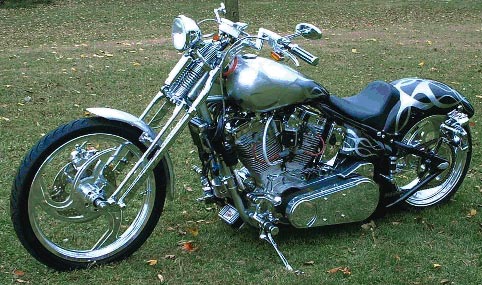
That 113" billet motor has a base price of nearly $10,000.00 and for those of you who havenít been down that road before the costs can quickly escalate way past $10,000.00 when all you ultimate thises and thatís like special chamber machining etc. are added in.
We get people on the phone all the time who have dumped $15,000.00 and more into engines and are still trying to straighten them out...or the people that bought a big hp custom-made engine of their dreams and are getting 27 mpg from their big inch collection of parts.
For $13,995.00 we give you a genuine 113"ORCA motor that makes more power, has better cylinders, better connecting rods, better pistons, better cylinder heads, bigger valves, more airflow, and a RSR Closed Loop Fuel Injection System valued at $3,595.00 instead of a $300.00 carburetor. The way it would appear, if you do the math, is that you get a far superior engine for less money and essentially get a closed loop fuel injection system for free. When you are building a bike it's all about the motor. Don't kid yourself, comparing an ORCA to a low hp billet p.o.s. is, like they say "bringing a knife to a gunfight".
If you want to park and talk, get some beauty to sit on your bike for pictures and agonize over the color of your pushrod tubes, get a billet engine with assembled parts from various manufacturers... Or, get an ORCA and get down the road with an efficient modern fuel system and a properly designed engine that makes the power you need.
Stock Frames, Aftermarket Frames Etc.

Pictured above is a 113" ORCA Turbo going in a 1988 FXR frame. The proximity of the oil tank and the raised ports require a special turbo exhaust manifold. Upper motor mount must ne cut and modifed. A 113" ORCA is essentially stock height so the rocker boxes can be removed with the engine in the frame. Protruding leads from the front cylinder head are for the S&S Electric Compression Release. A 132/139" ORCA definitely won't fit as it is almost 1" taller. If you are going turbo we have to know what the frame will be as we have different plumbing for oem, aftermarket, raked and non raked frames and often different designs depending on peg location. It gets complicated in Harley-land, the land that never heard of concurrent engineering.
How to Order Your ORCA
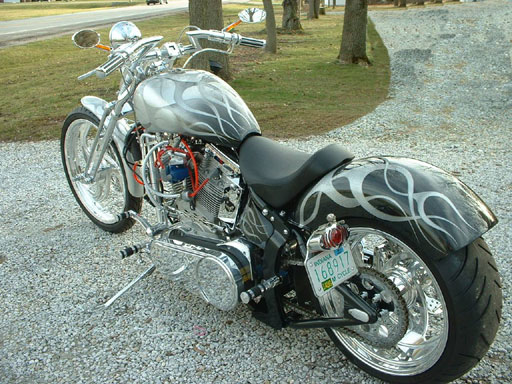
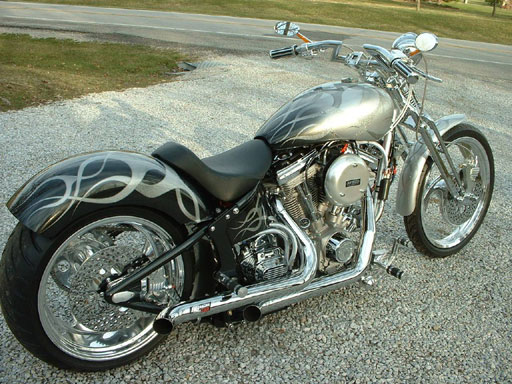
113/126/132/139" ORCAS are part of a complete system. Check out our Custom ORCA Order Page to see how the parts work together. Send us an email of your intended useage or give us a call for a technical consultation. We can provide you a detailed email response showing exact costs and comparison with billet based competitors. You will be surprised at the costs when you make an intelligent review of the facts.
We created this calculator so you could enter basic data on any Evo motor from a dead stock 80 Incher to a full tilt Turbo Orca. If you really want to get weird please feel free to do so because computers never get tired of you entering numbers and pushing keys. You will find the calculator helpful to calculate deck heights for custom piston, rod and cylinder assemblies. It is also very eye opening to see the effects of intercooling on turbo motors and the horsepower they make. We have also included calculations of the G Forces on the piston and piston pin as they hum away at the engine's redline...this might scare the shit out of you! Rod ratios, piston speeds, horsepower, airflow, temperatures...it's all there. For a dynamic simulation of your bore / stroke / rod length / camshaft / static compression / altitude / and boost variables check out our RSR Advanced Dynamic Compression Calculator.